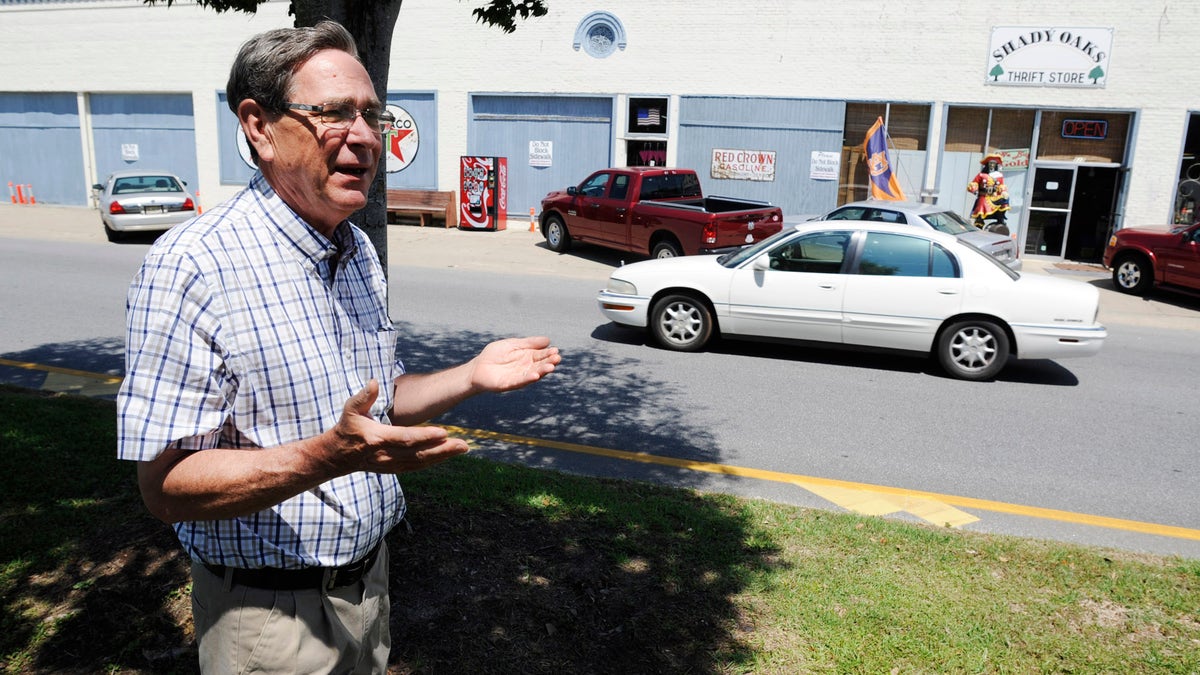
May 7, 2014: Steve Rodgers stands outside his thrift store as he discusses his support for a plan to widen U.S. 431 through historic Eufaula, Ala. (AP)
EUFAULA, Ala. – Travelers heading through southeast Alabama to Florida Panhandle beaches have a four-lane road the entire way except for a half-mile stretch in Eufaula. That section, gracefully lined by Southern mansions and giant oaks, narrows to two lanes.
Now the town finds itself in a battle of Southern charm vs. traffic congestion as the state makes plans to widen U.S. 431 and remove some trees.
City officials and historic preservationists say it would strike a huge blow to the city's heritage -- and heritage-related tourism that helps drive the economy in town of 13,000 situated on the Chattahoochee River.
"It is one of the most photographed streetscapes around. It is an iconic image for Alabama," said Mike Bunn, executive director of the Historic Chattahoochee Commission.
State Transportation Director John Cooper said Alabama has spent $150 million to complete the last four-lane stretches of U.S. 431 from Interstate 85 to the Florida line. The half-mile stretch through Eufaula's historic district is the only part of the 137-mile highway that remains two lanes.
"From a transportation standpoint we have spent too much on this corridor and this corridor is too important to the state, particularly the southeast corner of the state, not to pursue trying to eliminate this bottleneck," Cooper said in an interview.
U.S. 431 carries lots of trucks and tourists, particularly from the Atlanta area. As they approach Eufaula, the four-lane highway divides into two single lanes separated by medians 30 to 50 feet wide. The medians are filled with crepe myrtles, azaleas and giant live oaks that create a canopy with the huge oaks in front of mansions from the 1800s. Those mansions anchor a historic district with nearly 700 buildings.
The historic homes were filmed for the 2002 movie "Sweet Home Alabama" to serve as Reese Witherspoon's hometown. The street is also the busiest two-lane stretch of road in Alabama, averaging 21,000 vehicles a day, Cooper said.
Mayor Jack Tibbs said traffic does back up on busy weekends for beach tourism, but the town uses police officers to keep the vehicles moving. He said the tourism created by the historic district is too valuable to the town to risk running four lanes of traffic through it and destroying its beauty. "It is our calling card," he said.
In April, transportation workers drove stakes into the medians to show the maximum amount that could be cut away for a four-lane road. It varies from about a foot to 6 feet on each side, but Cooper said the average along the route is 5 feet on each side. He predicts tree damage will be minimal.
City officials disagree and cite a university study to back up their view. "It's going to cut off feeder roots and kill the trees eventually," town horticulturist Sherry Burchett said.
Dee Kellogg saw the historic homes in Eufaula as a 14-year-old and became determined to have one eventually. When she and her husband Don retired in Moab, Utah, they bought a home on North Eufaula Avenue and made her dream come true in 2008. They spent $1 million on the purchase and restoration. Now they worry about what will happen to their property values.
"This is the heart of Eufaula. It is cherished not just by the people who live here, but by the people who visit here," she said.
Erwin and Kristina De Boel of Antwerp, Belgium, are among those visitors. They decided to take a vacation focused on Southern history and stopped in Eufaula after visits to Charleston, South Carolina and Savannah, Georgia.
Kristina De Boel said European cities spend lots of money to protect their heritage and keep tourists coming. She can't imagine why anyone would think about doing anything that might damage Eufaula's calling card.
"The value of these houses and what they mean to the city would go down," she said.
The state has looked at other options during the last 20 years, including various bypass routes and dividing the existing 19-foot-wide lanes into two lanes. But there has always been opposition to each idea, Cooper said.
Steve Rodgers owns Shady Oaks Thrift Store where the four-lane highway squeezes to two lanes. Cars race in front of his store to get in front of 18-wheelers before they enter the two-lane stretch. Rodgers would prefer a four-lane through the historic district rather than a bypass.
"A bypass would kill downtown," he said.
Cooper said a bypass is no longer an option because Alabama's 16-cent-a-gallon gas tax hasn't been raised since 1992, and the state doesn't have $120 million to $150 million that would be needed for the project. He said widening U.S. 431 through the historic district would cost less than $2 million. One reason is the state already owns the medians and wouldn't have to buy any land.
Projects on U.S. highways are normally done with a mix of state and federal funds, but Cooper is proposing to do the widening entirely with state funds. Opponents see that as cutting off one avenue of fighting the project.
"In this case, it clearly leaves the debate at the state level," Cooper said.
Cooper said his department will do traffic studies this summer and have more talks with city officials before making a decision.
Gov. Robert Bentley, who appointed Cooper and is running for a second term, said all interests will be considered.
"We've got four lanes to the north, four lanes to the south and one little bottleneck right there going into two lanes. So it's tough," he said.




